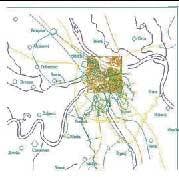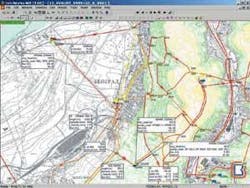Renewing Belgrade's water infrastructure
By Djordje Andrejevic
Situated on the banks of the rivers Sava and Danube, the citizens of Belgrade, the capital city of Serbia and Montenegro in the Balkans, have long benefited from ready access to water.
Rapid development after the Second World War led to the city expanding across the left bank of the Sava River with the development of an urban settlement called Novi (New) Beograd. The city's southern expansion took a different shape, culminating during the last decade with the establishment of hundreds of illegal settlements and private houses destroying the last traces of urban planning. The city population increased to more than 1.5 million.
In the past 110 years, the population of Belgrade has increased 25 times and yet the quantity of water distributed has increased 110 times. This is testament to the quality of the city's infrastructure engineering and the commitment shown to utility investments at various stages of the city's history. The Belgrade Waterworks and Sewerage Company was founded in 1892 and Oscar Smreker, an engineer from Mannheim, designed the city's original distribution system. Smreker's combined spring and Sava River distribution system supplied water directly from the city's reservoirs to the consumer, and the Belgrade Water-works became widely recognised throughout Europe as one of the leading utilities of its day.
However, years of underinvest-
ment and the turbulence of the 1990s caused the city's water supply system to rapidly decay. Sustained foreign donations, particularly from Germany, and increased investments by city authorities, including g30m since 1999, has helped the water utility improve services. The company now annually supplies 250 million m3 of potable water.
Belgrade's water supply is based on the treatment of raw groundwater, primarily from the River Sava but also a little from the Danube. A system of vertical and horizontal drains collect 60% of this water. The maximum capacity of the groundwater source area has been steadily dropping, a reminder that source water is not just a technical water catchment facility but also a natural environment to be protected. In 1960, six wells with an average capacity of 182 litres per second (l/s) supplied source water; however by 2000 the number of wells increased to 99, but average capacity fell to 42 l/s.
The city's water supply system consists of 200 km of raw water pipeline, 142 wells, 28 storage tanks, 26 pumping stations and 7 water plants. Raw groundwater is treated in three treatment plants - Bezanija (3,200 l/s), Banovo brdo (4,200 l/s) and Bele vode (600 l/s). Raw surface water taken from the River Sava is treated in four water treatment plants Makis (2,000 l/s), Jezero (1,000 l/s), Bele vode (500 l/s) and Vinca (80 l/s). Belgrade's 21 zone reservoirs (water storage tanks) represent one-third of the city's daily consumption, and substantial parts of the city are not fed by reservoirs at all. This places a substantial additional load on the city's pumping stations.
Given the city's topology, Belgrade is divided into four pressure zones. The first zone is located 75 to 125 metres above sea level, while each subsequent zone 50m higher. The water storage tanks for each zone are located 20 to 25m above, and they also act as the draining points for the pumping stations of higher zones. The highest tank is located 300m above sea level.
Built in 1961, a 1.8-m-diameter hydrotechnical tunnel connects the Banovo brdo water treatment plant with the city's central areas. This tunnel carries more than 50% of the total water supply for Belgrade. It runs through three Belgrade hills (Banovo brdo topcidersko brdo and vracarsko brdo), with several main pumping stations along its route (Topcider (1,2 zone), Vracar(1,2 zone) and Tasmajdan (1.zone)). The tunnel's capacity of 4,400 l/s is crucial to providing the city with a regular water supply, and its viability has been threatened by under-investment since 1990. It is one of the best examples of vision and planning; Belgrade citizens would have suffered water shortages throughout the 1990s without the tunnel.
The city's water distribution system consists of 2,500 km of pipe, 14,000 hydrants and 12,000 valves. Sixty-two percent of the network was built in the past 25 years, a further 23% is up to 50 years old and 15% is up to 100 years old. The old age and poor condition of the network account for frequent leakages and failures in the distribution system.
Belgrade Waterworks has long recognised the importance of understanding network performance through mathematical modeling and applying this knowledge to the development of infrastructure plans.
The mathematical modeling of Belgrade's water supply and distribution network dates back to the mid-1970s with the development of a mainframe-based VDS mathematical model. Used mainly in planning and design, this manual, tabular-based model offered no graphical representation of network behaviour. The model was calibrated according to reservoir water levels. The model contained Q-H (flow) characteristics of every pump in the pumping stations.
In the mid-1980s this manual model was transferred to a PC with a separate model for each pressure zone. By 1990, modeling had evolved further with Wallingford's early software product WESNET providing an integrated model covering raw water supply and the distribution network. The model shown in Figure 1 illustrates what could be achieved with the final version of WESNET. The whole model is displayed but with poor graphics and layer control. Simulation results were saved only for specified nodes and links.
Currently, Belgrade Waterworks' rehabilitation and reconstruction strategy emphasises water loss reduction and efficiency improvements. To help achieve this, the company invested in an advanced hydraulic modeling software system and consequently acquired InfoWorks WS from Wallingford Software, based in Wallingford, England.
Once the existing WESNET models were imported into InfoWorks, Belgrade Waterworks began the process of refining the new models, taking full advantage of the additional functionality and graphical capabilities of InfoWorks. Scanned images and background map images were integrated into the models and live data from pressure and flow loggers incorporated. The company now has a very useful strategic model of the water supply network comprising 540 nodes, 740 links, all the city's reservoirs, pumping stations and water storage tanks, four water treatment plants and 575 km of pipes. The model has direct links to GIS and SCADA data to optimise operator performance.
InfoWorks makes it possible to easily integrate different maps in the model, and to instantly view simulation results. InfoWorks communicates well with all the hydraulic and GIS programs Belgrade Waterworks previously employed, but users find its graphical capabilities particularly helpful. Flexible and detailed visual representations enable users to see the big picture and performance over time, and focus on the performance of individual pressure zones or installations. By the middle of next year InfoWorks will have helped balance all four water supply zones, and at the end of this year the SCADA system will be in operation and direct connection with live data will be possible. Currently, Belgrade Waterworks finds InfoWorks' GIS capability advantageous for model building and presenting results, but soon the utility expects to realise many more benefits of the software.
Belgrade Waterworks is already making significant headway in improving system performance by monitoring and analysing network performance at a strategic level across the supply and distribution system. The company, for example, can manage flow pressures and levels between zones. The next stage is to develop more detailed models as currently an individual node might represent a group of customers, such as a residential block or neighbourhood, rather than an individual customer. Once this is achieved, it will be possible to analyse network performance at a very low level and identify and resolve local weaknesses in the network.
Considerable work remains to provide the city's citizens with a water supply and distribution system capable of meeting their current and future needs. Using the latest modeling simulation technologies, however, Belgrade Waterworks is assured of developing a system whose behaviour and performance can be clearly understood and predicted. This in turn will enable the utility to educate consumers about water availability and usage so that the community as a whole can share in the responsibility for the proper use and effective maintenance of the city's limited water resources.
Author's NoteDjordje Andrejevic is the head of the department of water supply development at Belgrade Water, located in Belgrade, Serbia.



